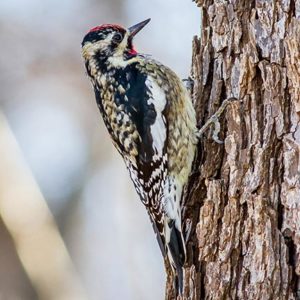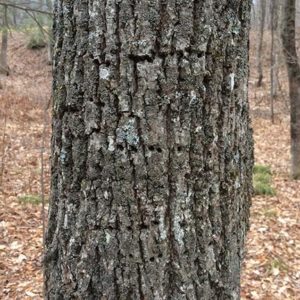Yellow-bellied sapsuckers (Sphyrapicus varius) are a unique species of woodpecker. At some point during the year, they can be found throughout most of Canada and the eastern half of the U.S. However, unlike our other woodpeckers, the yellow-bellied sapsucker is migratory with distinct summer and winter ranges. They also have a unique feeding style.
Despite the first half of their common name, the yellow belly of a yellow-bellied sapsucker isn’t as much of a help in identifying this species as one might hope. The “yellow belly” reminds me of an old piece of paper that has been left to weather and age in the sun. Sometimes it is basically just an off-white color with the slightest yellowish tinge and other times it can be a much more distinct yellowish color, but still doesn’t come anywhere close to a bright, sunflower yellow.

Yellow-bellied sapsuckers are a medium sized woodpecker. Like most of our woodpeckers, they are mostly black and white. Their backs have a messy, checkered pattern that, to me, kind of looks like they have lichen growing all over their backs. Their wings are mostly black with a white stripe that runs down the length of the wing. Yellow-bellied sapsuckers are our only woodpecker that has this vertical, white wing stripe. Both sexes have a red forehead and streak going across the top of the forehead. Males also have a red throat patch.
Most yellow-bellied sapsuckers migrate. In the summer, they’ll breed and raise their young in Canada and some of the far northern states. In the fall they head south for the winter. Their winter range extends basically from Virginia, across the southern portions of Ohio, Indiana, and Illinois, into Kansas and then south into Central America. The exception to this rule is the Appalachian yellow-bellied sapsucker which is a subspecies that breeds in the Appalachian Mountains.
For most of us, our primary interactions with yellow-bellied sapsuckers is going to be during the winter when they will hang out in open woods, orchards, and woodlots including wooded subdivisions, parks, and cemeteries. A good way to tell if they are visiting an area is to look for the tale-tale marks they leave in trees.
Yellow-bellied sapsuckers create rows of evenly spaced, small holes in the trees that they visit. These holes are called sap wells. Sometimes there will only be one or two short rows or lines of sap wells on a tree. Sometimes the sap well rows will be longer and almost encircle the tree. Other times, there will be multiple rows on one or more sides of the tree that create almost a grid-like pattern of holes. These sap wells contribute to the second part of the yellow-bellied sapsucker’s name and are an important tool for its unique feeding style.
Unlike most of our woodpeckers, yellow-bellied sapsuckers primarily feed on tree sap, not insects. After creating a sap well and letting it fill up with sap, the yellow-bellied sapsucker will insert its tongue and lap up the sap. (The common name is a bit of a misnomer because they lap the sap out of the wells instead of sucking it out.) In addition to tree sap, yellow-bellied sapsuckers also eat ants, spiders, and other bugs, bits of a tree’s cambium (the thin layer between a tree’s bark and the wood), and occasionally berries or other fruit. In the winter, they will sometimes visit suet feeders.

In the eastern U.S., yellow-bellied sapsuckers are the only woodpecker to create horizontal rows of holes in a tree. So, finding a row of sap wells means that a yellow-bellied sapsucker has been through that area. If the sap in the wells looks relatively fresh, then you know that a sapsucker has been actively using those wells fairly recently, which gives you a place to start looking for them.
Several studies have shown that yellow-bellied sapsuckers tend to prefer feeding on larger diameter trees over smaller diameter trees. Their feeding habits also typically don’t appear to cause too much long-term damage to the health of the trees. However, occasionally, that’s not the case. Although not common, it is possible, especially on smaller diameter trees in urban or suburban settings, for yellow-bellied sapsuckers to damage the tree.
Some research suggests that yellow-bellied sapsuckers prefer to feed on trees that are already damaged or weakened, so the visible sapsucker damage could be an indication of a previously undiagnosed issue. However, some studies didn’t find a preference for weakened trees, which complicates the situation because you don’t know for sure whether the sap wells are the problem or a symptom of a larger problem.
If you feel like yellow-bellied sapsuckers are causing too much damage to a tree in your yard, then you can try temporarily wrapping burlap or maybe window screen around the affected area of the trunk. Hopefully, this will create enough of a barrier for the sapsucker to eventually become discouraged and move to a different tree. You might also want to talk to your county extension agent or local forester to see if they can identify a broader underlying issue with the tree in case the sapsucker was being drawn to your tree because it was weakened from something else.
Despite the rare problem, yellow-bellied sapsuckers are interesting winter birds to our area. They are unique in multiple different ways and the sap wells they create are often visited by other animals who feed on sap or other sweet substances. Even when I can’t find the birds themselves, I always enjoy finding their sap wells and knowing that they’ve been there.

Backyard Ecology: Exploring Nature in Your Backyard
Nature isn’t just “out there.” It’s all around us, including right outside our doors. Hi, my name is Shannon Trimboli, and I am the host of Backyard Ecology. I live in southcentral Kentucky and am a wildlife biologist, educator, author, beekeeper, and owner of a nursery specializing in plants for pollinators and wildlife conservation. I invite you to join me as we ignite our curiosity and natural wonder, explore our yards and communities, and improve our local pollinator and wildlife habitat. Learn more or subscribe to my email list at www.backyardecology.net.

Leave a Reply